Policing of the pro-Palestine counter-rally at the ‘Never Again Is Now’ event at Parliament House on Sunday 19 May, 2024
Melbourne Activist Legal Support (MALS) expresses concern regarding the discriminatory policing, excessive use of police force, and obstruction of legal observers witnessed at the pro-Palestine counter-rally at the ‘Never Again Is Now’ event at Parliament House on Sunday 19 May, 2024.
Introduction
On Sunday 19 May, 2024, Melbourne Activist Legal Support (MALS) fielded a team of eight trained legal observers at a counter-rally taking place at Parliament House in Melbourne’s CBD.
The counter-rally took place within the broader pro-Palestine movement, which has been visibly and consistently active in Melbourne as well as across Australia since October 2023. The counter-rally was attended by various community groups as well as individuals.
The counter-rally was held in response to the anti-Palestine ‘Never Again Is Now’ (NAIN) event organised by a pro-Zionist Christian organisation. NAIN advertised a performance event starting at 1:30 pm and a rally to start at 2:30 pm and end at 4:00 pm. The NAIN event website claimed the organisation was ‘working closely with Victoria Police to ensure community safety on the day’.
The counter-rally started at Parliament House at 11:00 am and ended approximately six hours later at around 5:30 pm. The counter-rally was independent of the regular ‘Free Palestine’ rally which has consistently marched from the State Library to Parliament House every Sunday since early-October 2023 with a modified route during Ramadan. However, due to NAIN advertising that their event would take place at Parliament House on Sunday 19th May, the ‘Free Palestine’ rally diverted from its usual established route. Some participants from the ‘Free Palestine’ rally joined the counter-rally at Parliament House at approximately 2:45 pm.
The legal observer team was dispersed across the protest site from 11:30 am until 5:20 pm. Legal observers monitored and recorded police manoeuvres, conduct, and interactions with protesters and members of the public. The team observed hundreds of police officers from various units working in shifts throughout the day including approximately 150 uniformed divisional police officers, 20 Public Order Response Team (PORT) officers, 10 mounted branch officers, 10 plainclothes officers/detectives, and four Evidence Gathering Team (EGT) officers. The legal observer team recorded six arrests by police.
Throughout the day, the legal observer team noted several areas of concern as described below. Several recommendations to Victoria Police stemming from these observations are included at the end of this Statement of Concern.
Observations
Discriminatory policing and police targeting certain people
Legal observers noted several incidents of discriminatory and biased policing and targeting of counter-rally protesters including Victoria Police:
- aggressively and forcefully moving counter-rally protesters away from the Parliament House precinct after the counter-rally had already taken up their position at approximately 11:00 am in front of Parliament House;
- forcing the counter-protesters down Spring Street at least one block north of Parliament House at approximately 11:45 am, well before the advertised start time of the NAIN event, and holding this line for the duration of the NAIN event;
- setting up roadblocks, barriers, and police tape from approximately 10:30 am to approximately 4:50 pm to create an excessively large perimeter around Parliament House, which prevented people and vehicles from entering or returning to the area for a large portion of the day (see Figures 1, 2 and 3);
- blocking off laneways, paths, and public gardens leading to Parliament House and directing protesters who wished to join the counter-rally away from the counter-rally;
- attempting to thwart people from attending the counter-rally by giving false information that the counter-rally was not at Parliament House but at the State Library; and
- asking people if they were attending the counter-rally then blocking access to the area if they said they were, while allowing thoroughfare to those who said they were not.
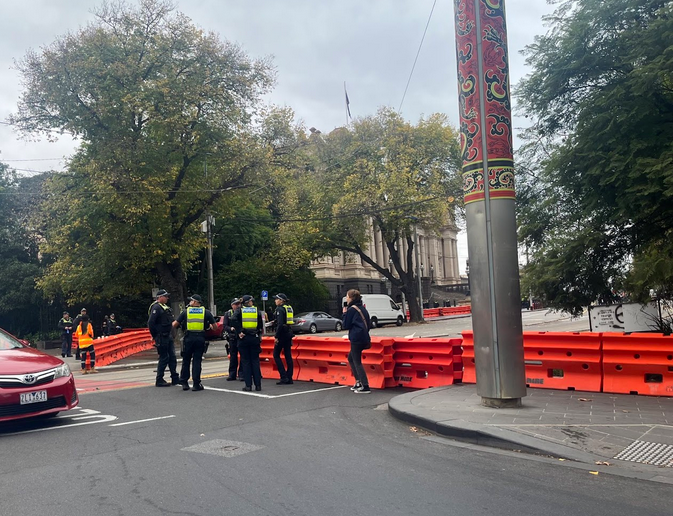
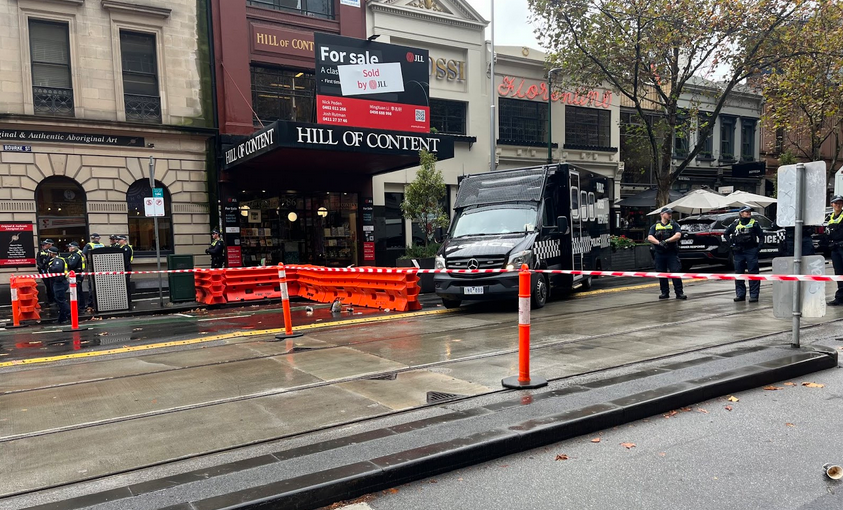
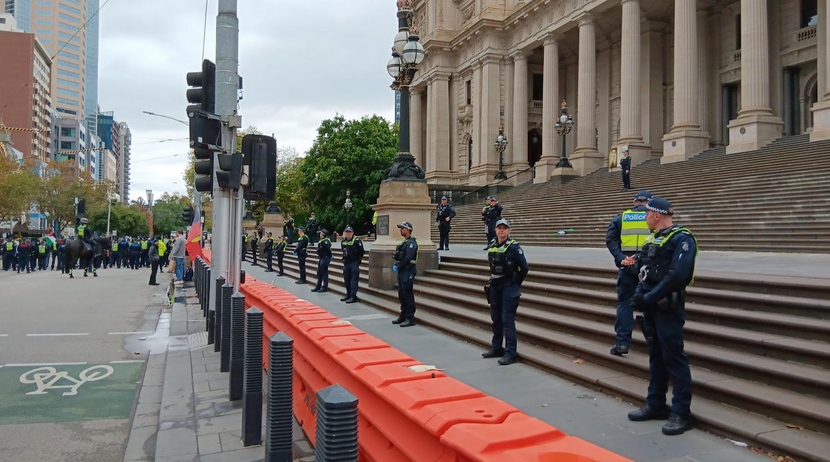
In contrast to the above, legal observers observed Victoria Police facilitating access to the Parliament House area for NAIN protesters including:
- allowing a truck to enter the Parliament House area at 12:30 pm where equipment for the NAIN rally was unloaded, including infrastructure for a stage;
- deploying divisional, PORT, and mounted branch officers forming protective lines and entry points around the Parliament House precinct and, from approximately 11:45 am, allowing NAIN protesters to move through and behind police barricades and facilitating their access to the Parliament House precinct while not letting other pedestrians through;
- informing pedestrians that only NAIN protest organisers were allowed into the area; and
- directing NAIN protesters to climb over roadblocks and barricades with PORT officers clearing pathways to allow access to the area.
Commentary:
Human rights standards identified in the Victoria Police Manual (VPM) require police to act compatibly with human rights under section 38 of the Human Rights and Responsibilities Charter Act 2006, and prohibit police officers from unreasonably or disproportionately impeding these fundamental human rights through acts of harassment, abuse, or physical violence (Chief Commissioner of Police, Human Rights Standards, 2021).
The VPM also recognises that a human rights breach occurs when a human right is negatively impacted by a decision and there is no proportionate justification (Chief Commissioner of Police, Human Rights Standards, 2021). The VPM directs police officers to treat people as being equal before the law without discrimination of any kind. In Victoria, the Charter of Human Rights and Responsibilities protects every person’s right to freedom of assembly.
It is MALS’ view that Victoria Police’s operational decisions and actions constitute biased policing against counter-rally protesters by restricting their legal right to protest in a public space, in particular, by breaching the ‘sight and sound’ principle which asserts that protests, including spontaneous assemblies and counter-rallies, should be able to take place within sight and sound of their target (United Nations Human Rights Council 2016:7). In contrast, Victoria Police provided more favourable policing to the NAIN rally by forcing counter-rally protesters to move far away from their established location to create space for the NAIN rally, defending and controlling access to a large area of public space on behalf of the NAIN rally, and interfering with the right of counter-rally protesters to lawfully assemble in breach of Article 5 of the International Covenant on Civil and Political Rights.
Police officers allowing NAIN protesters to enter the Parliament House precinct through police lines while holding back counter-rally protesters created an extremely tense environment due to the objective perception of preferential treatment police were giving NAIN protesters. The police’s operational approach of facilitating the NAIN event while pushing counter-rally protesters far away and preventing people from joining the counter-rally contributed to the escalation of tensions and conflict throughout the day.
MALS continues to be greatly concerned about discriminatory policing of certain community groups exercising their right to protest. These police actions can damage society’s democratic foundations, repress people’s civil and political rights, and undermine police claims that they respect human rights laws and operate free of bias and discrimination against certain members of the public.
Disproportionate deployment of police resources; dangerous police manoeuvres; excessive use of force
Over the course of the day, legal observers counted approximately 150 uniformed divisional police officers, 20 PORT officers, 10 mounted branch officers, 10 plainclothes officers/detectives, and four EGT officers. Legal observers noted the police worked in shifts with groups of officers replacing others in various locations.
When legal observers first arrived at the location at 11:30 am, there were approximately 100 people at the counter-rally. Approximately 50 divisional officers were also present, a clearly disproportionate mobilisation of police resources. Further, the number of police officers mobilised gradually grew over the day, with police significantly and consistently outnumbering counter-rally protesters from approximately 12:20 pm.
This massive deployment of police resources allowed police to employ a variety of tactics and operational manoeuvres against protesters (see Figures 4, 5 and 6). Legal observers witnessed multiple instances of excessive and unreasonable force used against protesters including:
- police forcefully moving a protester’s wheelchair resulting in it being damaged;
- pushing, shoving, and hitting people who were acting lawfully;
- yelling loudly and aggressively directly in people’s faces;
- scuffling with protesters to restrict their access to public spaces;
- planned PORT manoeuvres, formations, and drills including aggressively surging and charging into the crowd; and
- repeated threats to use batons and OC spray (oleoresin capsicum, or ‘pepper’ spray) against protesters as a crowd control tool.



The police’s highly aggressive approach to the counter-rally protesters resulted in escalating tensions and created the circumstances for physical contact between police and:
- people who were trying to get out of the way,
- people who wanted to remain where they were, and
- people who could not move easily due to injury or mobility issues.
These police manoeuvres and operational tactics accompanied by the use of excessive force against protesters resulted in anger, confusion, and distress. Police threats to use batons and OC spray on the crowd further contributed to crowd confusion, panic, and distress. These actions along with the use of force increased tension, fear, and anger amongst the crowd.
Legal observers also noted several incidents of mounted police surging towards counter-rally protesters. One particularly concerning incident occurred at 12:06 pm where legal observers witnessed police arresting a counter-rally protester by forcibly holding them in a face-down position whilst having their arms restrained behind their back with zip ties. The person’s position on the road was dangerously close to the hind legs of a police horse that was visibly unsettled and was shifting its position back and forth and side to side, indicating that it was not under the police officer’s control (see Figure 7).

Mounted police were also used to facilitate PORT officers as they prepared to charge into protesters (see Figures 8 and 9). In two separate instances, at approximately 2:14 pm and 2:47 pm, horses surged towards protesters to enable PORT officers to charge into the crowd of protesters. This caused panic and fear resulting in large numbers of protesters running in different directions seeking safety, and created an extremely unsafe situation where people were at significant risk of serious injury.


EGT officers were also present the entire time, with legal observers counting approximately four EGT officers working in two teams. These officers continuously video-recorded protesters and legal observers, often recording at close range to protesters (see Figures 10, 11 and 12).
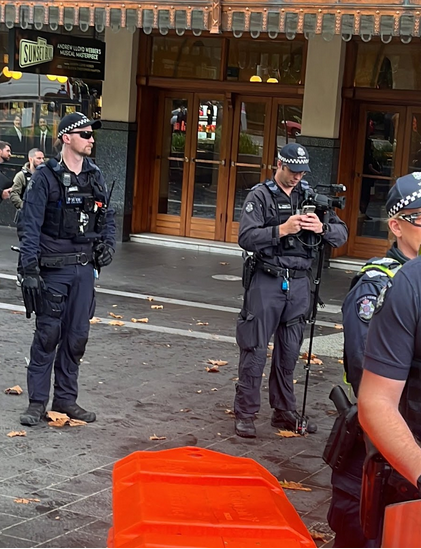
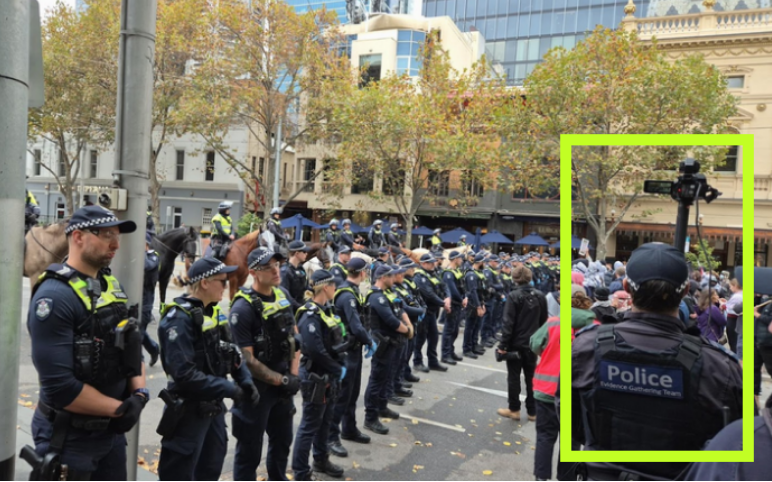
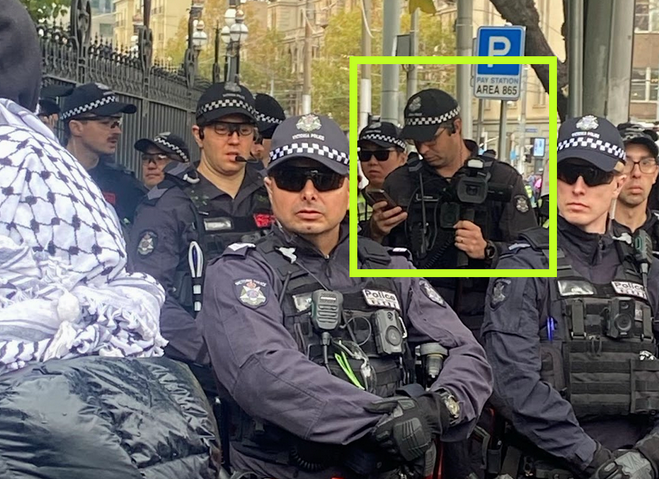
A police surveillance drone was also observed flying over the top of counter-rally protesters at various points in the day. One Mobile Policing Unit (MPUs) was also on-site; MPUs serve as command and control centres for large policing operations and include the capability to receive live streaming and other data directly from EGT officers in the field (see Figure 13).
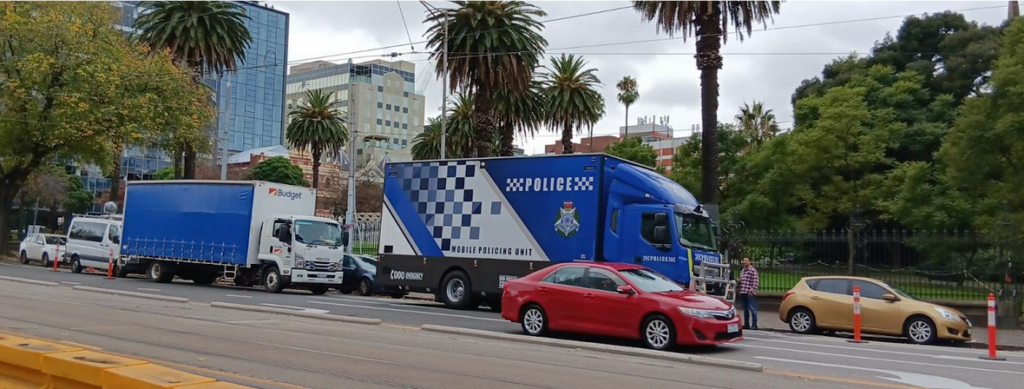
At least two arrest buses, 30 PORT vehicles, and numerous divisional vans were located around the Parliament House precinct throughout the day. Police officers were also observed carrying several pepper ball magazines for kinetic impact projectile (KIP) rifles (see Figures 14 and 15). The mobilisation of these resources indicates that Victoria Police’s operational response to counter-rally protesters was planned in advance and in anticipation of violence and mass arrests.


Commentary:
Australia is a party to the international human rights treaty, the International Covenant on Civil and Political Rights (ICCPR), which protects the right to freedom of assembly under Articles 21 and 22 (Attorney-General’s Department n.d.). As such, the right to protest as a form of political communication and expression is protected in Australia. In the state of Victoria, the right to freedom of assembly and the right to freedom of expression are also protected under the Charter of Human Rights and Responsibilities. These mechanisms provide protections for people exercising their right to peaceful protest as a legitimate tool of political expression.
It is formally recognised that peaceful protest can be disruptive and includes actions such as noisy disruptions, directing actions towards an identified target, and occupations of public places such as roads and footpaths. In United Nations Human Rights Committee General comment No. 37 (2020), peaceful protest is recognised as:
- “… peaceful assemblies wherever they take place: outdoors, indoors and online; in public and private spaces; or a combination thereof. Such assemblies may take many forms, including demonstrations, protests, meetings, processions, rallies, sit-ins, candlelit vigils and flash mobs. They are protected under article 21 whether they are stationary, such as pickets, or mobile, such as processions or marches” (United Nations Human Rights Committee 2020:para. 6), and
- “Their scale or nature can cause disruption, for example of vehicular or pedestrian movement or economic activity. These consequences, whether intended or unintended, do not call into question the protection such assemblies enjoy” (United Nations Human Rights Committee 2020:para. 7).
Mere pushing and shoving or disruption of vehicular or pedestrian movement or daily activities do not amount to ‘violence’, therefore these actions are protected under the right to freedom of assembly and police must not inhibit, restrict, or punish protesters who engage in such actions (United Nations Human Rights Committee 2020:para. 15). Further, isolated incidents of non-peaceful actions by some assembly participants does not render the entire assembly non-peaceful (United Nations Human Rights Committee 2020:para. 18). As such, police must not attribute these actions to all assembly participants as a collective and they must ensure any use of force is directed only at specific individuals engaging in non-peaceful behaviour (United Nations Human Rights Committee 2020:para. 86).
Regarding the use of force by police, the VPM states:
“… the goal of policing activities is to minimise harm caused by the actions of police or the actions of others. This is a broader concept that extends beyond the use of force and physical injury. It encompasses human rights, psychological and emotional harm and other impacts on community safety and confidence.” (Chief Commissioner of Police, Operational safety and the use of force, n.d.)
Under sections 462A and 463B the Crimes Act 1958 (Vic) police may use force to prevent serious offences from taking place, during an arrest, or to prevent a suicide. Any use of force must be reasonable, necessary, proportionate to the threat faced, and in accordance with legal requirements found in legislation, the common law, and the Charter of Human Rights and Responsibilities (Human Rights Law Centre 2011:7). As such, any use of force used by police with the aim of restricting people from exercising their right to protest may constitute excessive use of force.
The number of police officers, including PORT and the mounted branch, was disproportionate and excessive compared to the number of protesters present. High numbers of police, particularly when disproportionate to the number of protesters present, can act as a fear and intimidation tactic as well as increase the likelihood of dangerous police manoeuvres being used against protesters. Rather than de-escalating tension, such excessive police responses can serve to escalate tension and directly contribute to creating conflict.
The mobilisation of MPUs and EGTs enables significant and pervasive forms of police surveillance. Choosing to take part in a public assembly is not an invitation to surveillance and denial of privacy. MALS reiterates previous concerns about the unnecessary surveillance of protesters and the intimidatory effect this can have on people’s rights to engage in political demonstrations. United Nations Human Rights Council General Comment No. 37 (para. 62) reinforces the protection of the right to privacy:
“The mere fact that a particular assembly takes place in public does not mean that participants’ privacy cannot be violated. The right to privacy may be infringed, for example, by facial recognition and other technologies that can identify individual participants in a crowd. The same applies to the monitoring of social media to glean information about participation in peaceful assemblies.” (United Nations Human Rights Council 2020)
Obstruction of legal observers
Despite initially being restricted from making contact with the Forward Commander (FC) and being told by police officers that there were ‘a few FCs’, legal observers were eventually able to introduce themselves to the FC to explain the role of legal observers including documenting arrests and other interactions between demonstrators and police.
Despite the FC and other police officers being aware of their presence and role, legal observers reported multiple instances of being pushed and shoved by police, police preventing and obstructing them from recording arrests, and blocking their access to areas where altercations between police and protesters were taking place including arrests.
Police also physically restricted legal observer access to the counter-rally on multiple occasions, including by PORT officers and senior officers holding the rank of Leading Senior Constable and Sergeant.
At approximately 2:51 pm a legal observer was almost knocked under a police horse by a mounted officer. A potentially serious injury was prevented only by another legal observer grabbing them and pulling them back just before the mounted officer surged through the crowd.
Commentary:
Any use of force against legal observers is entirely unacceptable. MALS has raised the issue of legal observer obstruction with Victoria Police on several previous occasions.
When legal observers cannot make direct contact with on-site FCs, their ability to relay concerns promptly and directly to appropriate police members is hindered. Establishing a direct communication link with the officer in charge at protest events is an essential element of the legal observer role and, as such, should be facilitated by the police officers present.
Independent monitoring of the policing of protests is essential for defending the right to organise and participate in public assemblies. The practice of independent scrutiny of police powers is recognised by the United Nations Human Rights Committee (UNHRC). The UNHRC describes monitoring as necessary for the exercise of the right to peaceful assembly, and emphasises the responsibility of law enforcement officials to “[protect] journalists, monitors and observers” (United Nations 2020:para. 74).
Legal observers have the right to observe, monitor, and document police actions at protests and other actions without obstruction, including being allowed access to locations and spaces where they can clearly observe police actions:
“… [observers] may not be prohibited from, or unduly limited in, exercising these functions, including with respect to monitoring the actions of law enforcement officials. They must not face reprisals or other harassment, and their equipment must not be confiscated or damaged. Even if an assembly is declared unlawful or is dispersed, that does not terminate the right to monitor.” (United Nations 2020, para. 30)
Although legal observers position themselves to secure satisfactory vantage points to film police actions, they do not hinder, obstruct, or otherwise interfere with any police actions. The reason why legal observers have the right to observe police actions is evidenced in the footage captured by legal observers of police using force against protesters and the legal observers themselves- these are exactly the types of police actions that make it necessary for legal observers to monitor police operations to identify potential human rights abuses.
MALS is greatly troubled by the fact that several police officers restricted legal observers’ access to the protest area, disallowed them to closely observe arrests, and used physical force against legal observers. The obstructive actions and use of force by a Leading Senior Constable and a Sergeant against legal observers is of particular concern as senior officers are responsible for setting a behavioural standard for subordinate officers. When police officers in leadership positions conduct themselves in a manner that constitutes misconduct in breach of the VPM, this serves as a negative model of practice for other officers and contributes to the establishment and perpetuation of an operational culture of unlawfulness.
MALS has previously raised concerns about police mistreatment of legal observers with the Chief Commissioner of Victoria Police and the Victorian Human Rights Commissioner, and once again asserts that any restriction of or use of force against legal observers is entirely unacceptable.
Recommendations
- At a bare minimum, Victoria Police take proactive measures to ensure that officers comply with all laws and policies governing the use of force at public assemblies.
- The Independent Broad-based Anti-Corruption Commission (IBAC) and the Victoria Equal Opportunity and Human Rights Commission (VEOHRC) investigate the operational decisions made on Sunday 19 May 2024 as to the extent they may have breached the Charter of Human Rights and Responsibilities and what measures may be applied to prevent re-occurrence.
- Victoria Police consult with bodies such as the VEOHRC to review its Victoria Police Manual (VPM) policies, police attendance at events and incidents, operational planning, and operation orders in relation to all protest events to ensure that the right to freedom of assembly is not limited by operational tactics that demonstrate bias or allow or facilitate discrimination, and are aligned with the UNHRC General Comment No. 37 (2020).
- Victoria Police immediately restrict the mounted branch to ceremonial and patrol duties only, and specifically prohibit any use of police horses in public order or crowd control scenarios.
- Victoria Police specifically include the role of civilian legal and human rights observers within the Victoria Police Manual Crowd Control Guidelines (VPMG) and for Forward Commanders to brief operational members of the requirement to ensure the safety and access of legal observers who may be present at protest events.
________
Policy Rules contained in the Victoria Police Manual cited above are mandatory and provide the minimum standards that employees must apply. Non-compliance with or a departure from a Policy Rule may be subject to management or disciplinary action.
________
This Statement of Concern is a public document. It can be provided to media, Victoria Police,, the Independent Broad-based Anti-corruption Commission (IBAC), the Victorian Equal Opportunity and Human Rights Commission (VEOHRC), Government ministers, Members of Parliament, international human rights agencies, and other agencies upon request.
For inquiries regarding this statement please contact MALS at [email protected]
________
About Melbourne Activist Legal Support
Melbourne Activist Legal Support (MALS) is an independent volunteer group of lawyers, human rights advocates and, law students and paralegals. MALS trains and fields Legal Observer Teams at protest events, monitors and reports on public order policing, provides training and advice to activist groups on legal support structures and develops and distributes legal resources for protest movements. MALS works in conjunction with law firms, community legal centres and a range of local, national and international human rights agencies. We stand up for civil & political rights.